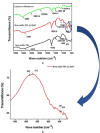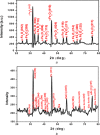Antifungal and antiovarian cancer properties of α Fe2O3 and α Fe2O3/ZnO nanostructures synthesised by Spirulina platensis
- PMID: 33399108
- PMCID: PMC8676415
- DOI: 10.1049/iet-nbt.2020.0055
Antifungal and antiovarian cancer properties of α Fe2O3 and α Fe2O3/ZnO nanostructures synthesised by Spirulina platensis
Abstract
Candida albicans (C. albicans) infection shows a growing burden on human health, and it has become challenging to search for treatment. Therefore, this work focused on the antifungal activity, and cytotoxic effect of biosynthesised nanostructures on human ovarian tetracarcinoma cells PA1 and their corresponding mechanism of cell death. Herein, the authors fabricated advanced biosynthesis of uncoated α-Fe2O3 and coated α-Fe2O3 nanostructures by using the carbohydrate of Spirulina platensis. The physicochemical features of nanostructures were characterised by UV-visible, high resolution transmission electron microscopy, Fourier transform infrared spectroscopy, and X-ray diffraction. The antifungal activity of these nanostructures against C. albicans was studied by the broth dilution method, and examined by 2', 7'-dichlorofluorescein diacetate staining. However, their cytotoxic effects against PA1 cell lines were evaluated by MTT and comet assays. Results indicated characteristic rod-shaped nanostructures, and increasing the average size of α-Fe2O3@ZnO nanocomposite (105.2 nm × 29.1 nm) to five times as compared to α-Fe2O3 nanoparticles (20.73nm × 5.25 nm). The surface coating of α-Fe2O3 by ZnO has increased its antifungal efficiency against C. albicans. Moreover, the MTT results revealed that α-Fe2O3@ZnO nanocomposite reduces PA1 cell proliferation due to DNA fragmentation (IC50 18.5 μg/ml). Continual advances of green nanotechnology and promising findings of this study are in favour of using the construction of rod-shaped nanostructures for therapeutic applications.
Figures












References
-
- Kontoyiannis D.P., Mantadakis E., Samonis G.: ‘Systemic mycoses in the immunocompromised host: an update in antifungal therapy’, J. Hosp. Infect., 2003, 53, pp. 243–258 - PubMed
MeSH terms
Substances
Supplementary concepts
LinkOut - more resources
Full Text Sources
Medical

